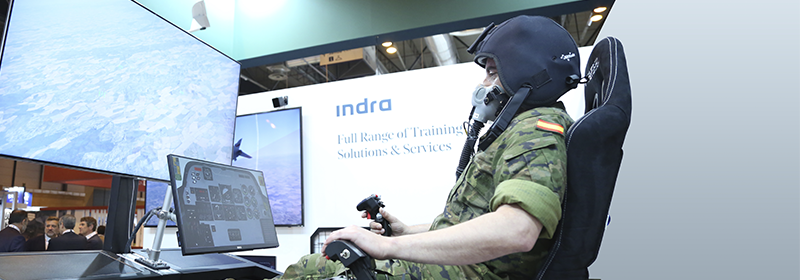- The pilots are trained to detect the symptoms of hypoxia, a state that can cause loss of consciousness
- This pioneering system increases their resilience and gives them a competitive advantage over pilots who have not received this training
- The simulator regulates the oxygen that pilots receive through their mask and it measures their physical and cognitive reaction second-by-second while completing a flight mission

Indra, one of the leading global consulting and technology companies, and the company that specializes in high-altitude sports training with the iAltitude system, has successfully completed the development of a novel Hypoxia flight trainer that is already installed in the Aviation Medicine Training Center of the Spanish Air Force in Madrid and is currently being used to train and provide greater endurance capacity in extreme scenarios to Spanish military pilots.
This system prepares them to detect in time the effects of hypoxia, a state that can lead to loss of consciousness, while also improving their capacity and endurance, by providing them with an important competitive advantage in combat.
The Flight Trainer-Controlled Normobaric Hypoxia (EV-HNC) consists of a C101 jet trainer - the same one used by Spanish pilots in their initial training, before taking the controls of an F18 or a Eurofighter - and iAltitude normobaric hypoxia equipment, which regulates the concentration of oxygen received by pilots through their mask.
It is one of the few systems available on the market that combines both types of training, which until now were carried out separately.
It is also one of the few that incorporates more advanced functionalities to monitor the physical and cognitive response of the trainee pilot in real time while carrying out a simulated mission.
It measures any change in the physiological variables or the speed of reaction to stimuli with great precision.
Thanks to this system, the Aviation Medicine Training Center will be able to design more effective training plans and reinforce the skills, abilities and safety of the pilots.
It will also be able to measure and manage the conditions of all pilots passing through the center in a centralized and unified manner. In this way, the center will prepare them to face a risk that, although it only occurs in exceptional cases, is critical for safety.
Until now, hypoxia training was carried out mainly in hypobaric chambers or in normobaric systems in which pilots could perform some exercises to detect the loss of sensory abilities, but without being linked to flight tasks.
This trainer from Indra and iAltitude is a great leap forward that will revolutionize the training of military pilots.
About iAltitude
iAltitude is a Spanish engineering and technology company which develops hardware and software in the fields of aerospace and sport. Since being set up in 2015, the company has developed the most advanced simulated altitude training system on the market which gives its customers the best environment available. Over the past year iAltitude has carried out several RDI projects at the Aerospace Medicine Training Center in partnership with the Spanish Air Force. iAltitude is currently involved in an aerospace engineering project the aim of which is to understand and enhance the responses of human beings to problems caused by lack of oxygen, thus ensuring their safety. Further information at http://www.ialtitude.es/.
About Indra
Indra (www.indracompany.com) is one of the leading global technology and consulting companies and the technological partner for core business operations of its customers world-wide. It is a world-leader in providing proprietary solutions in specific segments in Transport and Defense markets, and a leading firm in Digital Transformation Consultancy and Information Technologies in Spain and Latin America through its affiliate Minsait. Its business model is based on a comprehensive range of proprietary products, with an end-to-end, high-value focus and with a high innovation component. In the 2018 financial year, Indra achieved revenue of €3.104 billion, with 43,000 employees, a local presence in 46 countries and business operations in over 140 countries.